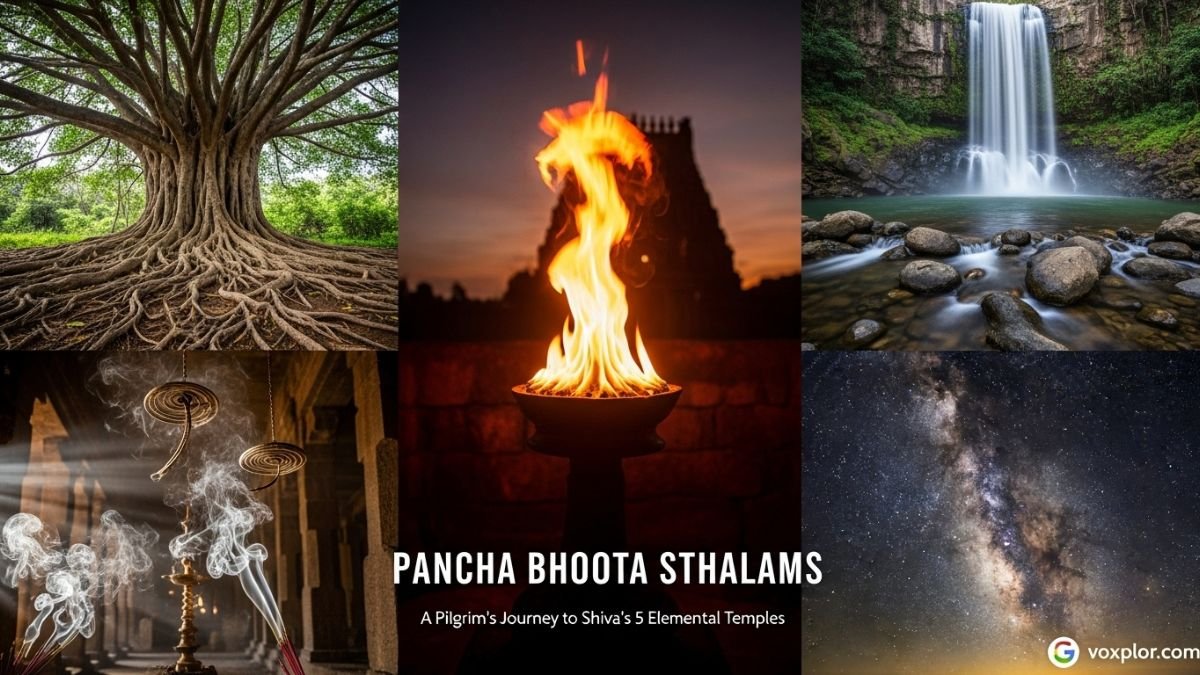Have you ever felt a profound connection to the natural world, a sense that you are part of something vast and ancient? For me, this feeling has always been a quiet hum in the background of a busy life. That is, until I embarked on a journey that transformed that hum into a powerful symphony: a pilgrimage to the Pancha Bhoota Sthalams in Southern India.
This isn’t just a trip. It’s an invitation. I want to share my firsthand experience of visiting these five sacred temples, each dedicated to Lord Shiva as a manifestation of one of the five primordial elements: Earth, Water, Fire, Air, and Ether (or Space). My goal was not just to see these places, but to feel them, to understand why for millennia they have been epicenters of spiritual energy.
If you’re seeking a journey that reconnects you to your core, that reveals the deep interplay between the universe and your being, then come with me. Let’s explore the path to the elemental heart of Shiva.
Understanding the Pancha Bhoota: The Universe Within Us
Before I set foot on this path, I spent considerable time understanding the “why.” In yogic and Vedic traditions, the universe and everything in it—including our bodies—is composed of five fundamental elements, the Pancha Bhootas.
- Prithvi (Earth): Represents stability, form, and groundedness.
- Jalam/Appu (Water): Symbolizes flow, flexibility, and the fluid nature of life.
- Agni (Fire): Represents energy, transformation, and light.
- Vayu (Air): Stands for movement, breath, and intangibility.
- Akasha (Ether/Space): Is the element of vastness, emptiness, and pure consciousness.
The Pancha Bhoota Sthalams are the five temples where Lord Shiva is believed to have manifested in these elemental forms. To visit them is to experience a living embodiment of this profound philosophy.
5 Dark Secrets of Brihadeeswarar Temple You Didn’t Know About
Ekambareswarar Temple, Kanchipuram: The Embodiment of Earth (Prithvi)

My journey began in the temple town of Kanchipuram, Tamil Nadu. The moment I stepped into the Ekambareswarar Temple complex, a sense of deep-rooted stability washed over me. This is where Shiva is worshipped as the element Earth, in the form of a Prithvi Lingam.
My Experience: I walked barefoot on the cool stone floors of the vast temple corridors, which cover an impressive 25-40 acres. The most moving sight is the sacred mango tree, said to be over 3,500 years old, under which, according to legend, Goddess Parvati fashioned a Lingam from sand to pray to Shiva. I closed my eyes and focused on my connection to the ground, feeling the stability and support of the earth beneath me. It was a profoundly grounding experience, a perfect start to the pilgrimage.
What Makes It Unique: The Lingam here is not carved from stone but is a Swayambhu or self-manifested Lingam made of sand. Legend holds that when Shiva sent a flood to test her, Parvati embraced the lingam to protect it, and her embrace left marks that are said to be visible to this day.
A Pilgrim’s Tip: Take your time in the hall with a thousand pillars and the 1008 Shiva Lingams. The energy is subtle but incredibly powerful, and it is a place where you can sit and meditate effortlessly.
Jambukeswarar Temple, Thiruvanaikaval: The Flow of Water (Jalam)

From the stability of earth, I traveled to the fluidity of water at the Jambukeswarar Temple near Trichy. This temple is dedicated to the Appu Lingam, representing the element of water.
My Experience: The unique feature here is that the inner sanctum has an underground water stream, and the Lingam is constantly submerged in water. I remember peering into the sanctum; the air was cool and damp. Unlike the grounded feeling in Kanchipuram, I felt a sense of release and emotional flow here. It was like the temple itself was inviting me to let go of rigidity and embrace change. The legend of the elephant and spider who once worshipped Shiva here adds a layer of beautiful symbolism about devotion in all its forms.
What Makes It Unique: The ever-present water in the sanctum, which is said to never dry up, is a powerful, living representation of the element. This temple symbolizes wisdom and learning, as it is believed that Goddess Parvati received ultimate knowledge from Shiva here.
A Pilgrim’s Tip: To honor the legend of Parvati’s penance here as a student, the temple priest dresses in a sari to perform the noon puja. Witnessing this unique ritual connects you deeply to the temple’s story.
Arunachaleswarar Temple, Tiruvannamalai: The Transformative Fire (Agni)

Next, I headed to Tiruvannamalai, home to the mighty Arunachala hill, considered a physical manifestation of Shiva himself. The Arunachaleswarar Temple at its base represents the element of fire, or Agni.
My Experience: The energy here is electric. It’s raw, powerful, and transformative. This is the Agni Lingam. The story goes that this is where Shiva appeared as a colossal pillar of fire to quell the egos of Brahma and Vishnu. As I stood before the sanctum, I could almost feel a purifying heat. The highlight for any pilgrim is performing Girivalam, the circumambulation of the Arunachala hill. I did this barefoot at dawn, and the 14-kilometer walk was a moving meditation, a shedding of old skins.
What Makes It Unique: The Arunachala hill itself is the primary object of worship, considered a lingam in its own right. The annual Karthigai Deepam festival, when a giant cauldron of ghee is lit atop the hill, is a breathtaking sight that draws millions of pilgrims.
A Pilgrim’s Tip: If you can, perform the Girivalam during a full moon (Pournami). The energy is believed to be at its peak. The walk is said to wash away sins and fulfill desires.
Srikalahasteeswara Temple, Srikalahasti: The Breath of Air (Vayu)

My journey then took me across the border to Andhra Pradesh, to the Srikalahasteeswara Temple, the abode of the Vayu Lingam.
My Experience: This temple felt different again. The central experience here is witnessing the lamps in the inner sanctum, which constantly flicker, even though there is no window or ventilation to let in a breeze. This is seen as proof of the presence of Shiva as the unseen element of air. I stood there, mesmerized, focusing on my breath—the Vayu within me. It was a powerful reminder that the most vital forces are often invisible.
What Makes It Unique: The flickering lamps are the undeniable experiential core of this temple. The main Lingam is also unique in that it is untouched by human hands, even by the priests. This temple is also famous as a kshetra for performing Rahu-Ketu pooja, a ritual to alleviate astrological afflictions.
A Pilgrim’s Tip: Spend at least 10-15 minutes just observing the main lamp in the sanctum. Try to sync your breath with its flicker. It’s a meditative practice that connects you directly to the temple’s energy.
Thillai Nataraja Temple, Chidambaram: The Consciousness of Ether (Akasha)

The final stop was perhaps the most profound: the Thillai Nataraja Temple, representing Akasha or Ether. Here, Shiva is not just a Lingam but is worshipped in his form as the cosmic dancer, Nataraja, and in his formless aspect.
My Experience: This temple explores the concept of form and formlessness. You worship the magnificent idol of Nataraja, representing the dynamic universe (form). But right next to it is the “Chidambara Rahasyam” (the Secret of Chidambaram)—a space behind a curtain, representing the formless, infinite nature of consciousness (Akasha). When the priest pulls back the curtain, you see nothing but a string of golden bilva leaves, symbolizing the transition from form to the formless. For me, this was the culmination of the entire journey. From the solid earth to the vast emptiness of space, it was a complete cycle.
What Makes It Unique: It is the only one of the Pancha Bhoota Sthalams where Shiva is represented by an anthropomorphic idol as the primary deity, alongside the Lingam and the formless representation. The name “Chidambaram” itself is a combination of “chit” (consciousness) and “ambaram” (sky), referring to the “sky of consciousness.”.
A Pilgrim’s Tip: Try to attend the daily pujas when the Chidambara Rahasyam is revealed. The moment is fleeting but incredibly impactful. Take time to sit and contemplate the dual concepts of form and formlessness in this temple, which is believed to be located at the lotus heart of the universe.
My Final Thoughts: A Journey Back to Myself
Visiting the Pancha Bhoota Sthalams was more than a tour of ancient temples; it was a transformative journey through the very elements that constitute my being. From the grounding earth of Kanchipuram to the infinite space of Chidambaram, I felt a deep and resonant alignment within myself.
This pilgrimage taught me that spirituality isn’t just an abstract concept; it is a tangible experience, something you can feel in the stones of a temple, the water of a sacred stream, the heat of a flame, the movement of the air, and the vastness of the sky.
If you choose to embark on this journey, go with an open heart. It won’t just show you the incredible culture and history of India; it will show you the universe that resides within you.


